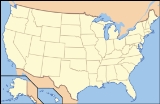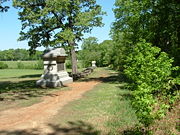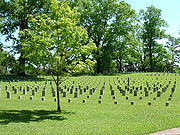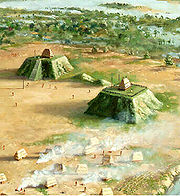
Shiloh National Military Park
Encyclopedia
Shiloh National Military Park preserves the American Civil War
Shiloh and Corinth battlefields. The main section of the park is in the unincorporated
town of Shiloh, about nine miles (14 km) south of Savannah, Tennessee
, with an additional area located in the city of Corinth, Mississippi
, 23 miles (37 km) southwest of Shiloh. The Battle of Shiloh
began a six-month struggle for the key railroad junction at Corinth. Afterward, Union
forces marched from Pittsburg Landing
to take Corinth in a May siege, then withstood an October Confederate
counter-attack.



was one of the first major battles in the Western Theater of the American Civil War
. The two-day battle, April 6 and April 7, 1862, involved about 65,000 Union
troops under Ulysses S. Grant
and Don Carlos Buell
and 44,000 Confederates
under Albert Sidney Johnston
(killed in the battle) and P.G.T. Beauregard. The battle resulted in nearly 24,000 killed, wounded, and missing. The two days of fighting did not end in a decisive tactical victory for either side —the Union held the battlefield but failed to pursue the withdrawing Confederate forces. However, it was a decisive strategic defeat for the Confederate forces that had massed to oppose Grant's and Buell's invasion through Tennessee. The battlefield is named after Shiloh Methodist Church, a small log church near Pittsburg Landing, Tennessee.
was designated a National Historic Landmark on May 6, 1991.,
The Shiloh National Military Park
was established on December 27, 1894. This was due to the requests of local farmers who had grown tired of their pig
s rooting up the remains of soldiers that had fallen during the battle, insisting that the federal government do something about it. The park was transferred from the War Department
to the National Park Service
on August 10, 1933. As with all historic areas administered by the National Park Service, the military park was listed on the National Register of Historic Places
on October 15, 1966.
 The Shiloh battlefield has within its boundaries the well preserved prehistoric Shiloh Indian Mounds Site
The Shiloh battlefield has within its boundaries the well preserved prehistoric Shiloh Indian Mounds Site
, which is also a National Historic Landmark
. The site was inhabited during the Early Mississippian period
from about 1000 to 1450 CE.
American Civil War
The American Civil War was a civil war fought in the United States of America. In response to the election of Abraham Lincoln as President of the United States, 11 southern slave states declared their secession from the United States and formed the Confederate States of America ; the other 25...
Shiloh and Corinth battlefields. The main section of the park is in the unincorporated
Unincorporated area
In law, an unincorporated area is a region of land that is not a part of any municipality.To "incorporate" in this context means to form a municipal corporation, a city, town, or village with its own government. An unincorporated community is usually not subject to or taxed by a municipal government...
town of Shiloh, about nine miles (14 km) south of Savannah, Tennessee
Savannah, Tennessee
Savannah is a city in Hardin County, Tennessee, United States. The population was 6,917 at the 2000 census and the 2007 population estimate was 7,262. It is the county seat of Hardin County. Savannah hosted the NAIA college football national championship game from 1996-2007. Savannah is home to...
, with an additional area located in the city of Corinth, Mississippi
Corinth, Mississippi
Corinth is a city in Alcorn County, Mississippi, United States. The population was 14,054 at the 2000 census. It is the county seat of Alcorn County. Its ZIP codes are 38834 and 38835.- History :...
, 23 miles (37 km) southwest of Shiloh. The Battle of Shiloh
Battle of Shiloh
The Battle of Shiloh, also known as the Battle of Pittsburg Landing, was a major battle in the Western Theater of the American Civil War, fought April 6–7, 1862, in southwestern Tennessee. A Union army under Maj. Gen. Ulysses S. Grant had moved via the Tennessee River deep into Tennessee and...
began a six-month struggle for the key railroad junction at Corinth. Afterward, Union
Union Army
The Union Army was the land force that fought for the Union during the American Civil War. It was also known as the Federal Army, the U.S. Army, the Northern Army and the National Army...
forces marched from Pittsburg Landing
Pittsburg Landing, Tennessee
Pittsburg Landing, Tennessee is a historic river landing on the west bank of the Tennessee River in Hardin County, Tennessee. It was named for "Pitts" Tucker who operated a tavern at the site in the years preceding the American Civil War...
to take Corinth in a May siege, then withstood an October Confederate
Confederate States Army
The Confederate States Army was the army of the Confederate States of America while the Confederacy existed during the American Civil War. On February 8, 1861, delegates from the seven Deep South states which had already declared their secession from the United States of America adopted the...
counter-attack.
Shiloh National Military Park



Shiloh battlefield
The Battle of ShilohBattle of Shiloh
The Battle of Shiloh, also known as the Battle of Pittsburg Landing, was a major battle in the Western Theater of the American Civil War, fought April 6–7, 1862, in southwestern Tennessee. A Union army under Maj. Gen. Ulysses S. Grant had moved via the Tennessee River deep into Tennessee and...
was one of the first major battles in the Western Theater of the American Civil War
Western Theater of the American Civil War
This article presents an overview of major military and naval operations in the Western Theater of the American Civil War.-Theater of operations:...
. The two-day battle, April 6 and April 7, 1862, involved about 65,000 Union
Union Army
The Union Army was the land force that fought for the Union during the American Civil War. It was also known as the Federal Army, the U.S. Army, the Northern Army and the National Army...
troops under Ulysses S. Grant
Ulysses S. Grant
Ulysses S. Grant was the 18th President of the United States as well as military commander during the Civil War and post-war Reconstruction periods. Under Grant's command, the Union Army defeated the Confederate military and ended the Confederate States of America...
and Don Carlos Buell
Don Carlos Buell
Don Carlos Buell was a career United States Army officer who fought in the Seminole War, the Mexican-American War, and the American Civil War. Buell led Union armies in two great Civil War battles—Shiloh and Perryville. The nation was angry at his failure to defeat the outnumbered...
and 44,000 Confederates
Confederate States Army
The Confederate States Army was the army of the Confederate States of America while the Confederacy existed during the American Civil War. On February 8, 1861, delegates from the seven Deep South states which had already declared their secession from the United States of America adopted the...
under Albert Sidney Johnston
Albert Sidney Johnston
Albert Sidney Johnston served as a general in three different armies: the Texas Army, the United States Army, and the Confederate States Army...
(killed in the battle) and P.G.T. Beauregard. The battle resulted in nearly 24,000 killed, wounded, and missing. The two days of fighting did not end in a decisive tactical victory for either side —the Union held the battlefield but failed to pursue the withdrawing Confederate forces. However, it was a decisive strategic defeat for the Confederate forces that had massed to oppose Grant's and Buell's invasion through Tennessee. The battlefield is named after Shiloh Methodist Church, a small log church near Pittsburg Landing, Tennessee.
Corinth battlefield
After the Battle of Shiloh, the Union forces proceeded to capture Corinth and the critical railroad junction there. On September 22, 2000, sites associated with the Corinth battlefield (see First and Second Battles of Corinth) were added to the park. The Siege and Battle of Corinth SitesSiege and Battle of Corinth Sites
Siege and Battle of Corinth Sites are a set of battleground areas in and around Corinth, Mississippi associated with the Siege of Corinth from April 29 to June 10, 1862, the Battle of Corinth from October 3 to October 4, 1862, and the lesser Battle of Hatchie's Bridge on October 5, 1862...
was designated a National Historic Landmark on May 6, 1991.,
Park information
- Total area: 3996.64 acres (16.173 km2)
- Federal area: 3941.64 acres (15.951 km2)
- Nonfederal area: 55 acres (0.22 km2)
The Shiloh National Military Park
National Military Park
National Military Park, National Battlefield, National Battlefield Park, and National Battlefield Site are four designations for 24 battle sites preserved by the United States federal government because of their national importance...
was established on December 27, 1894. This was due to the requests of local farmers who had grown tired of their pig
Pig
A pig is any of the animals in the genus Sus, within the Suidae family of even-toed ungulates. Pigs include the domestic pig, its ancestor the wild boar, and several other wild relatives...
s rooting up the remains of soldiers that had fallen during the battle, insisting that the federal government do something about it. The park was transferred from the War Department
United States Department of War
The United States Department of War, also called the War Department , was the United States Cabinet department originally responsible for the operation and maintenance of the United States Army...
to the National Park Service
National Park Service
The National Park Service is the U.S. federal agency that manages all national parks, many national monuments, and other conservation and historical properties with various title designations...
on August 10, 1933. As with all historic areas administered by the National Park Service, the military park was listed on the National Register of Historic Places
National Register of Historic Places
The National Register of Historic Places is the United States government's official list of districts, sites, buildings, structures, and objects deemed worthy of preservation...
on October 15, 1966.
Shiloh National Cemetery
Shiloh National Cemetery is in the northeast corner of the park adjacent to the visitor center and bookstore. Buried within its 20.09 acres (81,301.4 m²) are 3584 Union dead (of whom 2357 are unknown), who were re-interred in the cemetery created after the war, in 1866. There are two Confederate dead interred in the cemetery. The cemetery operations were transferred from War Department to the National Park Service in 1933.Shiloh Indian Mounds Site

Shiloh Indian Mounds Site
Shiloh Indian Mounds Site is a Mississippian culture archaeological site of the prehistoric indigenous peoples of eastern North America...
, which is also a National Historic Landmark
National Historic Landmark
A National Historic Landmark is a building, site, structure, object, or district, that is officially recognized by the United States government for its historical significance...
. The site was inhabited during the Early Mississippian period
Mississippian culture
The Mississippian culture was a mound-building Native American culture that flourished in what is now the Midwestern, Eastern, and Southeastern United States from approximately 800 CE to 1500 CE, varying regionally....
from about 1000 to 1450 CE.
External links
- NPS website: Shiloh National Military Park
- Civil War Trails
- NPS Shiloh Auto Tour Map linked to photo galleries
- Guide to records (appropriations and expenditures) for Shiloh National Cemetery, 1913 - 1933
- Guide to records (general administrative files) of Shiloh National Military Park
- Guide to records (register of visitors) to Shiloh National Cemetery, 1891-1932

